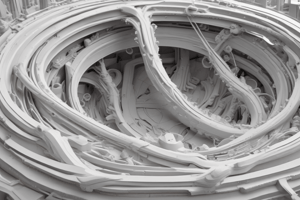Podcast
Questions and Answers
Which file format is commonly used for 3D printing?
Which file format is commonly used for 3D printing?
- .stl (correct)
- .jpg
- .mp3
- .txt
What is the purpose of an STL file in 3D printing?
What is the purpose of an STL file in 3D printing?
- To convert 3D models to 2D images
- To store images
- To create 3D models
- To provide instructions for the 3D printer (correct)
What is the difference between a 3D object and an STL file?
What is the difference between a 3D object and an STL file?
- A 3D object is a physical object, while an STL file is a digital file (correct)
- A 3D object is created using a 3D printer, while an STL file is created using 3D modeling software
- A 3D object is created using CAD software, while an STL file is created using a 3D scanner
- A 3D object is a digital file, while an STL file is a physical object
Which of the following is NOT a characteristic of an STL file?
Which of the following is NOT a characteristic of an STL file?
What is the maximum number of triangles that an STL file can have?
What is the maximum number of triangles that an STL file can have?
Which of the following is a disadvantage of using STL files for 3D printing?
Which of the following is a disadvantage of using STL files for 3D printing?
Which of the following factors does NOT affect the quality of a 3D print?
Which of the following factors does NOT affect the quality of a 3D print?
What is the main difference between FDM and SLA 3D printing technologies?
What is the main difference between FDM and SLA 3D printing technologies?
What is the main advantage of using a dual extruder 3D printer?
What is the main advantage of using a dual extruder 3D printer?
Flashcards are hidden until you start studying
Study Notes
3D Printing File Formats
- STL (Stereolithography) is the most widely used file format for 3D printing.
- An STL file describes the surface geometry of a 3D object using a series of triangles.
Purpose and Functionality of STL Files
- The primary purpose of an STL file is to provide a digital representation of a 3D model that can be interpreted by 3D printers.
- STL files lack color and texture information, focusing solely on the shape of the object.
3D Object vs. STL File
- A 3D object encompasses all aspects of a model, including geometry, color, and texture.
- An STL file is a simplified version that only contains geometric data, specifically the shape via triangles.
Characteristics of STL Files
- Characteristics not associated with STL files: they cannot store color or texture information.
- In terms of geometry, STL files can theoretically handle a vast number of triangles, but practical limitations exist depending on the software and printer capabilities.
Maximum Number of Triangles
- Theoretically, STL files can contain up to 2.1 billion triangles.
Disadvantages of Using STL Files
- A notable disadvantage is the loss of important detail like color and texture in the conversion to STL format.
Factors Affecting 3D Print Quality
- Factors such as printer calibration, material quality, and printing speed significantly affect print quality.
- Model complexity does not inherently affect the quality; it is more about how the printer processes the model.
Comparison of 3D Printing Technologies
- Fused Deposition Modeling (FDM) uses melted thermoplastic material extruded through a nozzle, while Stereolithography (SLA) employs a laser to cure liquid resin layer by layer.
- FDM is generally faster and more cost-effective, while SLA offers higher resolution and detail.
Advantages of Dual Extruder Printers
- The main advantage of using a dual extruder 3D printer is the ability to print with multiple materials or colors in a single print job, enhancing design possibilities and functionality.
Studying That Suits You
Use AI to generate personalized quizzes and flashcards to suit your learning preferences.




